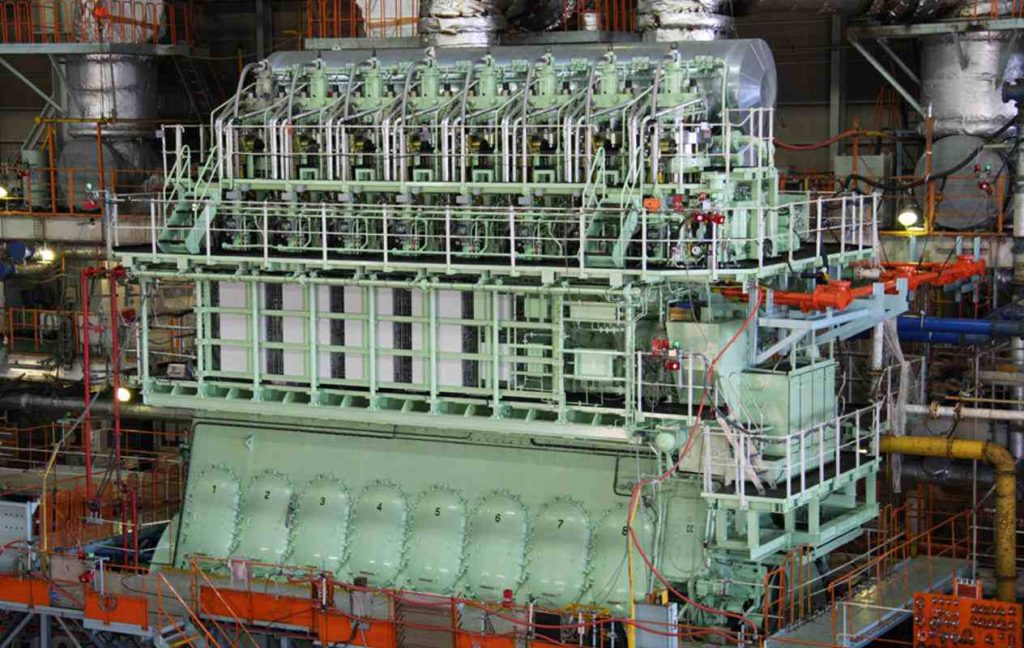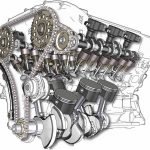The term medium refers to diesel engines that operate with in the approximate speed range 250 to 800 revolutions per minute. High speed is usually 100 rpm and above, while slow speed diesel engines have 100 to 120 rpm. Each has their various advantages and disadvantages for various duties on board ship.
The slow speed two stroke cycle diesel is used for main propulsion units since it can be directly coupled to the propeller and shafting. It provides high power, can burn low grade fuels and has high thermal efficiency. The cylinders and crankcase are isolated, which reduces contamination and permits the use of specialized lubricating oil in cylinders and bearings. The use of two stroke cycle usually means there are no inlet and exhaust valves. This reduces maintenance and simplifies engine construction.
The medium speed diesel engines are generally to operate on the four stroke cycle and are trunk piston construction. These egines provide a better power to weight ratio and power to size ratio and there is also a lower initial cost for equivalent power.
The higher speed how ever requires the use of gearbox and flexible coupling for main propulsion use. These engine may be constructed in either “In-line” or “vee configuration” (shape). Vee types engines are constructed with two banks of cylinders arranged at an angle using a common crankcase and bed plate with considerable saving in size and weight. The most common method for connecting two pistons to each throw of the shaft is the side arrangement with two bottom end bearings.
Various makes of medium speed engines
Various make of diesel engines are as under
MAN B&W L58 ENIGNES
Engine of this type have cylinders bore of 580mm and 640mm, stroke operating at 400rpm. This is larger medium speed four stroke diesel engines; these are in six and nine cylinders. All are in line and operate on heavy oil and are designated ease in maintenance with extanded periods between overhauls.
SULZER ZA 40S ENIGNES
The engine has cylinders bore of 400mm and a stroke of 500mm and normal speed of 510 rpm. This engine produced in many cylinder numbers, ranging from six to nine for “In-line” and twelve to eighteen for “vee form” engines.
SEMT PIELSTICK PC26 ENGINES
It is one of the wide ranges of medium speed engines produced by the company for marine and land applications and available as “In-line” or “Vee configuration”. The cylinder bore is 400mm, with a stroke of 400mm and speed of 520 rpm. Cylinder numbers are from six to nine for “In-line” and from ten to eighteen for “Vee” versions. These are four stroke engines.
WARTSILA VASA 46 ENGINES
Wartsila R-46 engines are medium speed four stroke engines having trunk piston. The engine has cylinder bore of 460mm, a stroke of 580mm and designated speeds of 450, 500 or 514 rpm . it is available with between four and nine cylinders “In line” or with between twelve and sixteen cylinders in “Vee form”.
Fuel system of this engines uses twin or pilot injection. This gives easy starting and smooth efficient combustion of low quality fuel over the full ranges of engine power.
ENGINE DESIGN
The principle design parameters for a medium speed diesel engines are:
- high power weight ratio
- simple, strong, compact and space saving.
- high reliability
- able to maintain the fact that components are smaller and lighter than those for slow speed diesels makes for easier handling.
- easily capable of adoption to un-manned operation
- low fuel and lubricating oil consumption
- high thermal efficiency
- low cast and simple to install
TYPE OF ENGINE
Either 2 or 4 stroke cycle single acting turbo charged with inline or vee cylinder configuration. The main choice is certainly at present, for the four stroke engine due to the following reasons.
- they are capable of operating satisfactory on same heavy oils which are used for slow speed two stroke engines.
- effective scavenging.
- higher mean piston speed which will give greater power.
- engine can operate effectively with turbocharger out of commission, this would present a considerable problem with some two stroke engine of the medium speed type.
- turbocharger power and size can be reduced.
- it is also claimed that the fuel consumption would be reduced.
- to reduce inertia forces use is made of aluminum alloy skirted piston or complete aluminum alloy pistons. Inertia forces must be taken into account for bearing loads. Important in trunk piston engines(which are the majority of medium and high speed diesels) where the guide surfaces is the cylinder liner, the smaller the side thrust the less the friction and wear.
The following are the data’s of medium speed diesel engine currently in use:
RPM 600, cylinder bore 400mm, 4stroke, turbocharged upto 18 cylinders, developing approx: 700KW per cylinder, break mean effective pressure 23 bar, maximum cylinder pressure 160 bars, at approx: 600 rpm.


